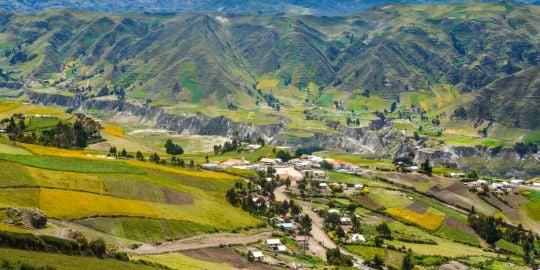Considering a trip from NJ - where to start?
Best beach areas to live
Most start by landing in Guayaquil and taing a 90 minute ride west to the coastal city of Salinas in the province of Santa Elena located on the Santa Elena peninsula that extends up the coast for about 50km -- though not a typical coastal location it is popular due to its modernized infrastructure and gives you a good base from which to branch out to the more rural areas including where I live and have my B&B in Anconcito (a small fishing village), Santa Elena (where we have the local University and some fascinating museums of both anthropology and archeology0 San Vicente (home of the famous Banos San Vicente healing mud baths) and Punta Carnero (which was recently featured on HGTV HHI).
From there you will probably want to travel northward to the Manabi province and the site of the oldest culture in the western hemisphere Valdivia (stop at the museums and checkk out the goddesses -- and the local aquarium where the children of the town help in the recuperation of injured sea animals) and the beach towns of Montanita and Olon (think Berkley on the Beach -- a hippy surfer town with great night life and kicked back day life) and on to Las Nunez and El Portal. At that point you pass through the rain forest known as Machallila which is an environmentally protected zone (try to set aside a day to go horseback riding through the forest and visit the monkeys.
Further north you come to the fishing village of Puerto Lopez which also has an excellent museum. This area also gives you access to the island of las Platas (known as the Frugal Galapagos). With many of the same flora and fauna as the Galapagos it is just 300 miles off the coast and unlie the Galapagos there is no $100 entry fee, nor rules against interacting with the animals -- yes you can swim with the seals and the turtles here.
Continuing up the coast you will come to Manta which has an airport that can fly you back to Guayaquil or on to Quito or keep heading north to Crucita for some parasailing, or on to Bahia Caraquez and Canoa for some more laid back beach life. Onward from there you enter Esmeraldas which is the most Caribbean like area of the coast -- this is an area that is indeed hot and humid with an African feel as it was settled by escaped slaves and has a special feel all it's own -- Atacames is a beautiful area and you will see why it is called Esmeraldas by the intense lush green of the area.
I have left out a LOT... and you will need time to see it all... get a feel of where you are comfortable, etc.
Things to keep in mind: The Pacific coast can be cool and sometimes even chilly -- that's a big air conditioner with a constant on switch -- so bring some long sleeves and pants and sweats with you. Bring insect repellent -- while Malaria and Dengue are a greater threat in the Amazon, mosquitoes do exist and they seem to love "the other white meat" also it's good for keeping sand fleas from biting your ankles -- and bring some cortisone cream in case you do get bit, it is sometimes hard to find in the local pharmacies. Also try to bring small bills ($1s and $5) anything larger than a $20 is very hard to break and some places won;t even accept them. And of course small change is great for haggling for things -- and negotiating is expected -- always counter with half what is offered, it is expected. You don't need to be fluent in Spanish -- but do have enough to be polite -- hello/goodbye/and THANK YOU go a long way -- and around here so does a smile, it ain't New Yawk (and yeah I'm originally from dah Bronx  )
)
Other than that -- take the plunge, come visit...and oh yeah ...maybe think of staying with us here at the Hideaway...just a suggestion.
Susan
TheOceanHideaway.com
Susan...what a well written informative reply to a question thought by many but not always asked. I have a few questions regarding our upcoming trip in Febuary.
1. We plan on renting a car in Guayaquil and driving the route you described. Are the roads marked clearly, conditions of roads and what should we be made aware of etc. We have read that you must be very careful driving in Guayaquil...your thoughts?
2. We will use this initial trip to investigate where we would like to reside for several months...a sort of home base. This will allow us to meet expats, locals etc. plus explore bussiness opportunities as we are not ready to retire. Can you direct us to a site where we can search furnished accomodations?
Any advice you may have would be greatly appreciated and please keep writing informative posts.
Thank you
George & Allison
PS: when we finalize travel arrangements for Feb we will book a few nights at your B&B.
Hi George & Allison:
The roads you will be driving on -- the via Costa to the coast from Guayaquil to Salinas and the Ruta del Sol (aka Ruta Spondylus) are both modern well paved roadways and direct routes to where you want to be.
That being said the most difficult part of renting a car in Guayaquil at the airport is -- getting the heck out of Guayaquil! Most of the rental agencies have well defined maps but if you find yourself lost what we always suggest is flag down a yellow cab, tell him you need to get to the Via Costa and pay him $5 to lead you to the on ramp. OR if you are more nervous than not, have the rental car agent come with you and give them cab fare to get bac to the airport. Both are commonly done here due to the confusing layout of the streets with overpasses and underpasses.
Now about renting a vehicle: do rent using a credit card that carries insurance and when picking up the car take a picture of all four sides of the vehicle with the rental agent in the picture. If at a later date you are assessed a charge for damage, you have a pictorial record of the day you picked up the car. If in fact there is damage to the vehicle (and we have hefty speed bumps in many little towns to slow traffic that can take out a muffler or cut a fuel line on a car with bad suspension) you are covered. Just an aside: the local namefor speed bumps is "chapas muertas" which translates to dead badges -- it's sort of a peculiar joke that speed bumps are deceased traffic cops who, after being hit by a speeding vehicle are immortalized by being covered in asphalt to create a bump in the road, thereby avoiding the same outcome to his replacement. Sick humor but kind of gives you an idea about driving in Ecuador.
About licensing: a legal license in the USA and an international rivers permit available from AAA (whether you are a member or not) will allow you to drive during your 30 day tourist visa period. Your rental car will also come with a matricula (registration) and SOAT (national basic insurance coverage). The police often have checkpoints where they will pull over every 5th car or so to do random checks of licenses and these documents. This is normal and nothing to be concerned about. Some police are unsure about the International Permit, simply as to speak to a supervisor if they appear confused. Many of the police are learning some basic English as their language skills will equal a great increasein salary level -- and they are aware that tourism is a major revenue producer in Ecuador and will want to assist you. That being said, they do expect you to be respectful and handle yourself as you would on a traffic stop in the USA -- belligerance is not acceptable and being the ugly American reflects badly on us all. Usually the stop will take no more than 5 or 10 minutes and you will be bac on the road with a friendly wave and a few practiced "Good Afternoons" and "Have a Safe Stay" becing called to you by your new police friends -- consider it part of the adventure.
Back to Guayaquil for a moment: If you are arriving after dark I suggest you arrange for car pick up the following day and locate lodging that has a van pick up service. Trip Advisor is a good way to find and contact most of the major hotels in Guayaquil such as Howard Johnsons, Oro Verde and Sheraton -- plus many others -- and having that van waiting when you arrive is well worth it. Have your hotel either arrange for the van to drop you bac at the airport in the morning or have the hotel concierge get you a taxi. This is where things can be hairy. Guayaquil and Quito both have had a rise in taxi hijackings -- including yellow cabs -- and it is best to have your hotel chose your taxi for you as they now who the vetted local drivers are.
If for some reason you choose not to rent but use a car service, take a look at the US Consulate website for Guayaquil here: http://guayaquil.usconsulate.gov/service.html Among the services they provide is a list of taxi services they have confirmed as safe and secure. You will also find the names of other individuals who can be helpful and it is worth just taking a look through the site and see first hand some of the information you may not even realize you needed to know!
About driving in Ecuador: People often ask "what side of the road to people drive on in Ecuador?" The best answer is: the side with the least potholes. While many of the major roadways have been recently repaired or rebuilt under the Correa administration, many others still await rehabilitation. Folks drive here lie they are the only ones on the road -- drive assertively and drive defensively and if you have a passenger, use that extra set of eyes to look out for pedestrians, bikes, livestock, and the ubiquiotous family motorcycle carrying 5 people and a 3 baskets of laundry. Oh and yes they drive -- supposedly -- on the right as we do in the states. And there is NO right turn on red -- and stop signs are more lie yield signs... uh...be careful and get out of Guayaquil in one piece. And did I mention that automatic shift is pretty much unheard of? So if you are renting and need automatice be sure to ask for it or you will be learning to drive a stick the hard way (and that is not a fun way to experience Ecuador...)
On to your econd question: best answer? Get here and start looking around -- talk to everyone and anyone -- there are some "hangouts" where we all seem to congregate, such as Hostal Aqui in Salinas. Word of mouth is both your best means of learning about opportunities, the lay of the land, who's for real and who blows a lot of hot air, who is a professional and who just claims to be one, and if anyone ever tells you to disregard the "scuttle butt", "grapevine", "gossip", or my favorite "don't take your advice from the bartender"... RUN.... do not walk...RUN in the other direction. The expatriate community is small and we are pretty much living in a fish bowl -- we know each other's lives and we know the "Ecua-tastrophes" each of us has weathered. We share these bits of information to deal with the pain of our mistakes, pass our knowledge on to others, and sometimes to brag a bit that we survived the adventure and continue to live and love living here in Ecuador. As the old radio show used to say "there are a million stories in the naked city" -- come and sit and listen and you will hear quite a few.
Now it sounds like your trip in February will be a hopscotch sort of trip -- pack lightly and be ready to travel with a few days in different places -- you can always go back and forth or stay longer in any one place if you like. Hostals are what we would consider motels back in the states and most have a range of accomodations from multi person dorm rooms to marital suites and even studio apartments. Note that anything that calls itself a Motel is a "buy by the hour" kind of place (wink wink) get it? And the same goes for the use of the term Pensione here. A Hostal simply means you have under 25 rooms but more than 10 and a Hotel is greater than 25 rooms. And Hostal and Hostel are equal terms just latin and european spelling. Again I reccomend Trip Advisor as a good search tool for finding places where you will be most comfortable. Keep in mind that a big holiday here, Carnival, will be celebrated the weeend of February 18 and 19 and continue through Monday the 20 and Shrove Tuesday (aka Mardi Gras) is the 21st. Lodging will be booked solid during that time and you will want to stay put -- preferably somewhere fun -- and stock up on water balloons and silly string (that will make much more sense when that week comes around.)
Okay -- that wraps up this edition of what to now and where to go ... Hope to get to meet you in person in a few months and keep those messages coming in!
Susan
TheOceanHideaway.com
Wow, Susan, this article is great! Thank you so much. God forbid that it should happen, but if a tourist or other expat is in an auto accident while in Ecuador what are the laws like? Is one likely to loose everything they have?
The question comes up because I've heard that Panama is REALLY tough on foreigners who have auto accidents.
Regards,
Cynthia
It's always good to have an attorney on speed dial -- but if it is a minor fender bender or something of the sort the police officer will often act as mediator and everyone gets sort of paid off -- the injured party goes to the clinic for xrays amd meds and the culpable party pays for that and a little thank you to the cop. If it is something major plead "no hablo" and call that attorney to come speak for you. It's not fun but it it can be handled.









